

Formative Assessment Tool. Faculty Focus Email. In the typical college classroom a small handful of students make the vast majority of comments. As a teacher you want to create a classroom environment that helps students of various learning styles and personalities to feel comfortable enough to contribute as well as understand the importance of class preparation and active participation.
To reach this goal requires a constant balancing act of encouraging quiet, reflective students to speak up and, occasionally, asking the most active contributors to hold back from commenting in order to give others a chance. On LinkedIn Group we asked members to share some of the strategies they use to engage students in discussion, manage the dominant talkers and the nontalkers, and steer a discussion that's gone off track.
Nearly three dozen faculty members shared their techniques for prompting discussion. Below are excerpts of just a few of the strategies shared. Essay on the value of intense discussion-based instruction. Established orthodoxy indicates that the ideal pedagogical method centers on small, discussion-based classes.
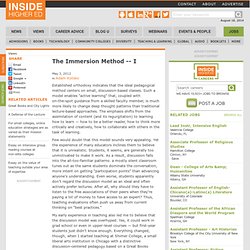
Such a model enables "active learning" that, coupled with on-the-spot guidance from a skilled faculty member, is much more likely to change deep thought patterns than traditional lecture-based approaches. By Mobify. Single Best Free Way to Transform Classrooms (Primary-Lifelong) of Any Size--and Fast Too!

It may sound like I'm selling snake oil, but I actually do have one trick that, at no cost, can transform your classroom or public speaking event, whether a seminar or a lecture, whether for 8 year olds or doctoral students, CEOs or senior citizens. You can try this tomorrow, and turn the biggest lecture into an interactive, collaborative experience without so much as an investment even in clickers or a projector. Every Student Response Strategies « LessonCast. True implementation of personalized learning in schools requires a shift in the roles of educators and a shift in educator professional learning.
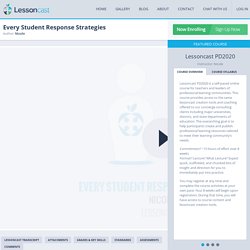
This course examines the evolving role of teachers incorporating personalized learning experiences in the classroom. Taking a close look at what personalized learning is and isn’t, participants create resources to support teacher roles as facilitator, assessor, instructional designer, content curator, coach, and advisor, and family-school collaborator. Lessoncast believes in personalized professional learning.
Several modules have assignment options. Participants may choose between the assignments according to which one is more applicable for implementing personalization in their learning environment. While the course opens on July 21 (8:00 am EST), you may register at any time and complete the course activities at your own pace. Blended Learning: Adding Asynchronous Discussions to Your F2F Classrooms. This post was co-authored with Elizabeth Alderton, Assistant Professor at the University of Wisconsin Oshkosh. --------- We have all done it: "participated" in a face-to-face discussion, nodding along in agreement, but not really present.
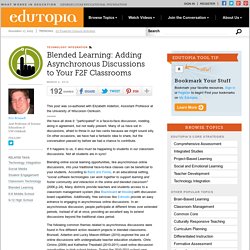
Student-Led Discussion Manual. Using Quizzes to Promote Student Engagement and Collaboration. January 26, 2012 By: Audrey Deterding, Ph.D. in Teaching and Learning.

Upgrade your KWL Chart to the 21st Century One of the take aways from the Curriculum Mapping Institute this past week was that it brought an upgrade to THE trusted KWL (Know, What to Know and Learned) Chart to the forefront.

It seems a no brainer…one of those things… “I should have thought about it”… So what is this upgrade all about? An “H” snuck into the Acronym! What does this “H” stand for”? Why is this an upgrade for the 21st century? I started out by searching Google, which immediately wanted to correct my search term and showed me the traditional “KWL chart” results. The top search results turned out mostly downloadable files for templates, which was quiet interesting as there were several explanations in these tutorials what the “H” could stand for: HOW can we find the answers to these questions? In direct relation to our quest to bring Information literacy in the 21st century to our teachers and students, the “HOW will we find the information” sticks out right away for me.
Related 12. Using Whiteboards in the Chemistry Classroom & Beyond. One of the most fascinating aspects of student learning is the way in which information is processed in a student's mind.
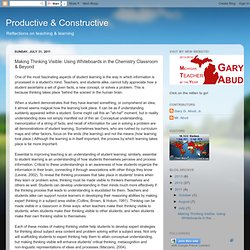
Teachers, and students alike, cannot fully appreciate how a student ascertains a set of given facts, a new concept, or solves a problem. This is because thinking takes place 'behind the scenes' in the human brain. When a student demonstrates that they have learned something, or comprehend an idea, it almost seems magical how the learning took place. It can be as if understanding suddenly appeared within a student. Online Discussion. Socratic seminars, fish bowls, and computers. October 6, 2011 by mrkaiser208 The concept of a fish bowl or Socratic seminar is not new.
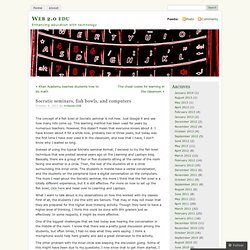
Just Google it and see how many hits come up. This learning method has been used for years by numerous teachers. However, this doesn’t mean that everyone knows about it. Top 12 Ways to Increase Student Participation. Call it "active learning," or "classroom participation" -- every teacher wants to know how to motivate students to particpate, and how to nurture more involved students and fewer apathetic ones.
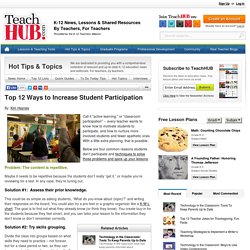
With a little extra planning, that is possible. Below are four common reasons students don’t participate and techniques to solve those problems and spice up your lessons. Problem: The content is repetitive. Maybe it needs to be repetitive because the students don’t really “get it,” or maybe you’re reviewing for a test.